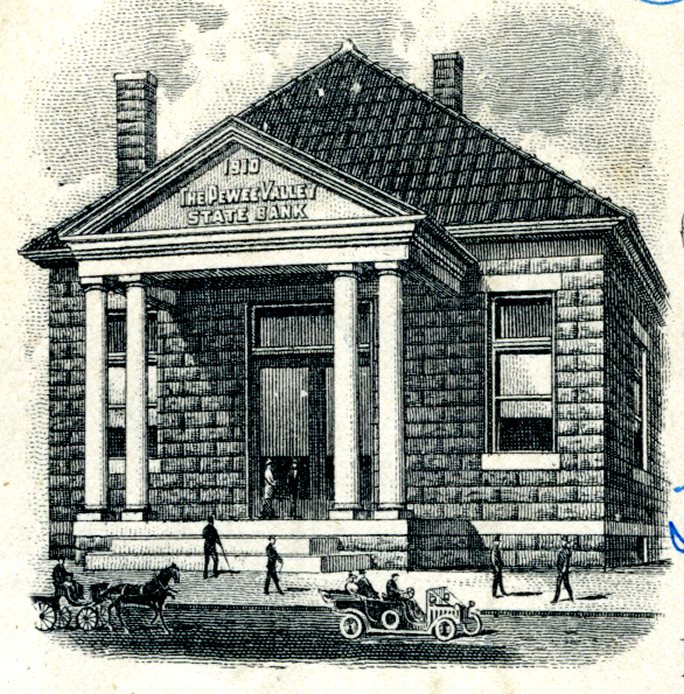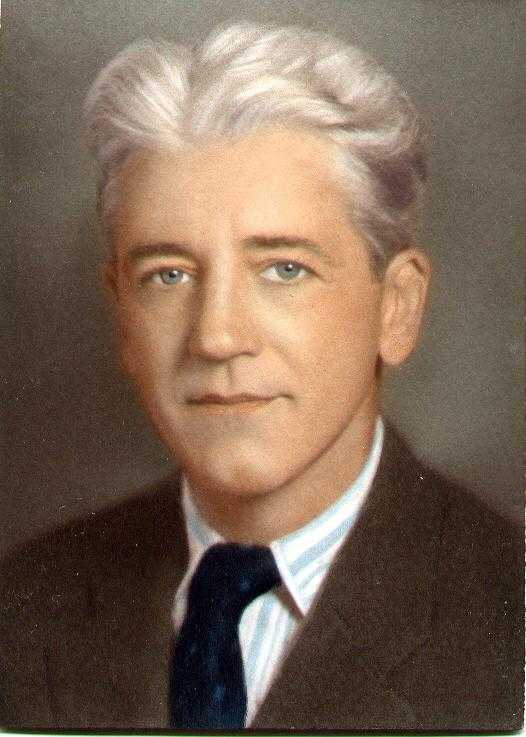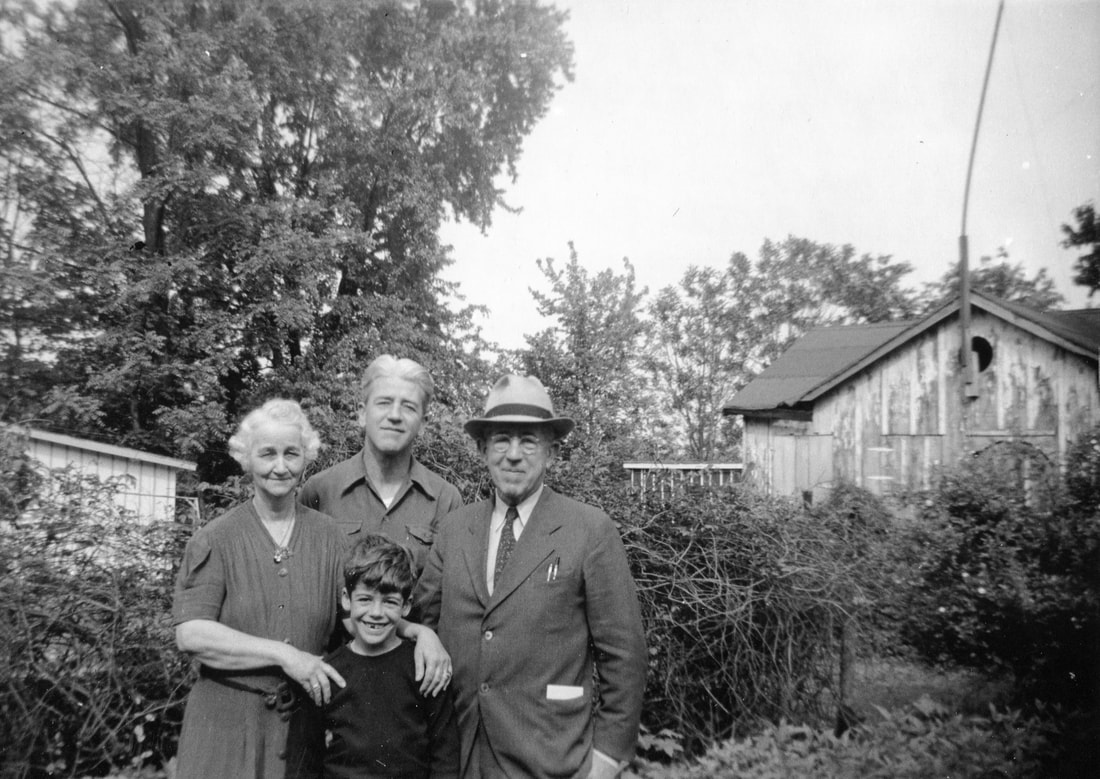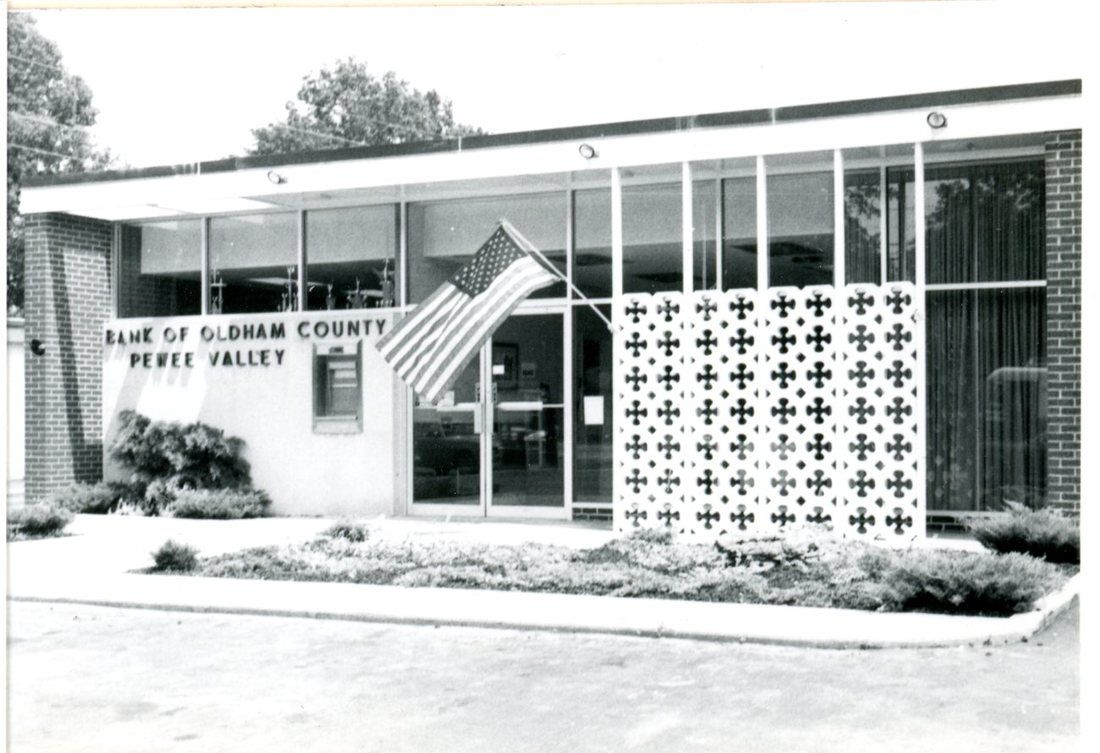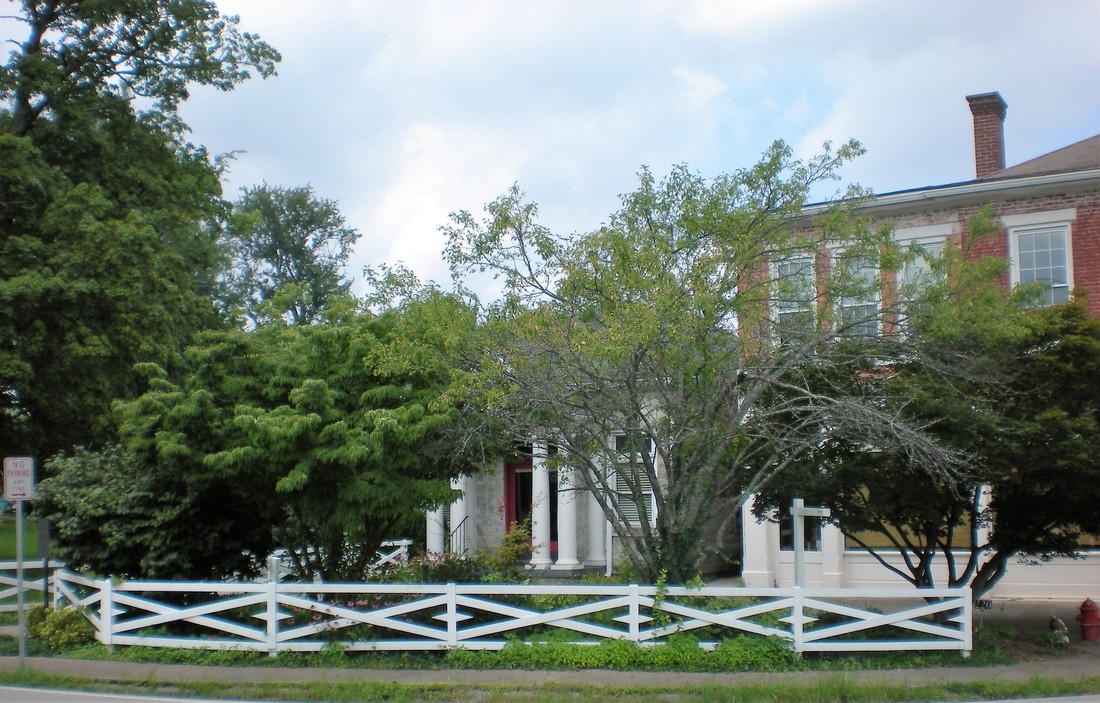Pewee Valley State Bank-Pewee Valley Woman's Club
The Pewee Valley State Bank: 1910-1963
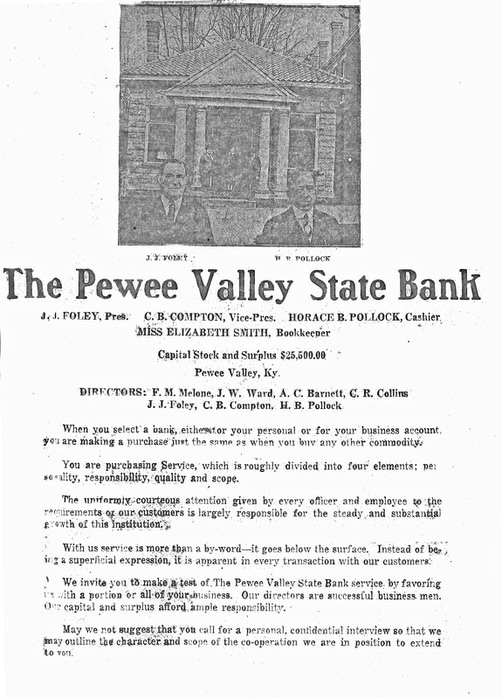 Pewee Valley State Bank ad, date unknown, from Katie S. Smith's papers
Pewee Valley State Bank ad, date unknown, from Katie S. Smith's papers
The Pewee Valley State Bank started taking shape in late spring 1910 when a group of local men came together and started a subscription. The effort was headed by Grant County, Ky., resident Jacob Hedger Blackburn, a banker with a track record of success. In 1899, he had helped organize the Bank of Germantown, Ky., in Morgan County and served as its first cashier. In 1904, he organized a bank in Russellville, Brown County, Oh.
The May 27, 1910 Courier-Journal reported:
SUBSCRIBE $15,000 FOR
BANK AT PEWEE VALLEY
Committee Selected to Purchase Site
-- Stockholders Named Directors
At a meeting yesterday afternoon of the businessmen of Pewee Valley, $15,000 was subscribed for the erection of a bank and a committee was selected to purchase a site for the building.
The name of the bank will be "Pewee Valley State Bank." The movement is backed by some of the most prominent business men of Louisville who live in Pewee Valley.
At a meeting of the stockholders yesterday afternoon the directors of the bank were chosen and they in turn will elect the officers of the institution. Following is the directorate: C.R. Long, Jr. (associated with the Short Line Railroad); William Ross; C.A. Calvert; Powhatan Wooldridge; Harry Hudson; W.C. Nuckols; Fred Hopkins; S.M. Melone; and James Foley.
The building committee is composed of William Ross, C.R. Long, Jr., and Mr. Blackburn, of Germantown, who is promoting the erection of the bank. Horace Pollock, of Germantown, has been selected as cashier of the new bank.
There will be a meeting of the directors on the first Saturday in June, when the president and vice president of the bank will be elected.
According to Katie S. Smith's "Pewee Valley: Land of the Little Colonel," published in 1974:
On July 12, 1910, Articles of Incorporation of the PEWEE VALLEY STATE BANK of Pewee Valley were filed and recorded in the Oldham County Court House. "Its object is to transact a general commercial banking business having all the rights, powers and privileges of such a corporation. Its capital stock shall be $15,000, --- divided into 300 shares of $50.00 each." The bank began business September 1, 1910....
The Pewee Valley State Bank remained a small-town financial institution for many years. Among the men who served as officers were James J. Foley, who owned the grocery store next to the bank; S.M. Melone, a farmer on Ash Avenue; Charles B. Compton, who was raised in Pewee Valley by Thomas and Nannette Schuler Compton; and Fred J. Kilgus, whose home was located on what is now Kilgus Circle off LaGrange Road in Crestwood.
Horace Bass Pollock: Cashier
|
While the directors and officers of the Pewee Valley State Bank changed over time, the cashier did not. Horace Bass Pollock was the institution's first cashier and remained in that position for a quarter of a century. Pollock proved "it's not what you know; it's who you know" that counts. The Germantown native and resident had been working as a clerk in a local store before he was selected for the coveted cashier job at Pewee Valley State Bank. And he had only completed school through the eighth grade, according to the 1940 census. The man responsible for getting him hired was bank organizer Jacob Hedger Blackburn, who just happened to be Pollock's brother-in-law. The 36-year-old banker had married Pollock's 21-year-old sister, Gertrude, on May 26, 1906 in Hamilton County, Oh. He soon took Horace under his wing. Pollock (November 24, 1874-February 13, 1945) left Germantown and moved to Pewee Valley with his wife, Ida Mae Galbraith (October 3, 1878-June 13, 1946). Married on October 7, 1897, they had two children when they arrived:
Years later, in 1918, Ida gave birth to a third child, Hallie Lee Pollock. She lived only 14 days and is buried in Pewee Valley Cemetery. In 1912, Horace and Ida purchased a lot and built a house on Railroad Avenue (now 112 Mt. Mercy Drive) for $600. The house was just a short walk from the bank. Seven years later, according to their grandson, Richard Horace Pollock, they bought another acre at the back of their lot where they built a barn and livestock pen for their goats and chickens and kept their vegetable garden. They lived on Railroad Avenue until 1944. The family photos at left are courtesy of Richard Horace Pollock. |
 Classified ad from the April 15, 1928 Courier-Journal
Classified ad from the April 15, 1928 Courier-Journal
In 1928, Pollock and J.J. Foley went into real estate development and created a subdivision off LaGrange Road near the Pewee Valley Hospital and Sanitarium. The subdivision wasn't within the city's boundaries at the time it was developed.
Two roads in it are named for its founders: Foley Avenue, where the Pewee Valley Fire Department's main station is located; and Pollock Avenue, running parallel to LaGrange Road. Pewee Valley has since annexed property on the east side of Foley, which includes the fire station.
In 1928, Pollock and J.J. Foley went into real estate development and created a subdivision off LaGrange Road near the Pewee Valley Hospital and Sanitarium. The subdivision wasn't within the city's boundaries at the time it was developed.
Two roads in it are named for its founders: Foley Avenue, where the Pewee Valley Fire Department's main station is located; and Pollock Avenue, running parallel to LaGrange Road. Pewee Valley has since annexed property on the east side of Foley, which includes the fire station.

The Pollocks moved to Crestwood after Horace retired and they sold their home in Pewee Valley. Horace died on February 13, 1945. His obituary ran in the Courier-Journal the next day:
H.B. Pollock, Banker
Dies at Age 70
Horace B. Pollock, 70, director and cashier of the Pewee Valley Bank for twenty-five years, died at 1:30 a.m. yesterday at his home in Crestwood. He retired two years ago because of ill health. He was a native of Germantown, Mason County, Ky.
Survivors are his wife, Mrs. Ida Mae Pollock; a son, Sam Pollock, principal of Madisonville High School; a daughter, Mrs. Bernice Flynn, Newport; two brothers, Dr. Mahlon Pollock, Washington, Ky., and J. Colburn Pollock, Louisville; and a sister, Mrs. Jake Blackburn, Williamstown, Ky. ....
His will, dated June 8, 1921, is on file at the Oldham County Courthouse. Thanks to Oldham County Clerk Julie Barr for providing the Pewee Valley Historical Society with a copy:
I, Horace B. Pollock, being of sound mind and a giving nature, do hereby will unto my beloved wife Ida Mae Pollock all of my property both real and personal, consisting of 1 lot in Pewee Valley, Ky, 22 shares of stock of the Pewee Valley State Bank. 1 Five Hundred Dollar bond in the Pewee Valley State Bank's box at the Kentucky Title Co Louisville, Ky. and whatever property I may have at my death, and appoint her Executrix of the estate without bond.
His wife, Ida Mae, died the next year (Courier-Journal, June 13, 1946):
Pollock, Ida Mae, in her 68th year, Thursday, June 13, 1946 at Maysville, Ky. Survived by her son, Sam B. Pollock; daughter, Mrs. Bernicee Guerrette, and 1 grandson. ...
They are buried in Floydsburg Cemetery.
H.B. Pollock, Banker
Dies at Age 70
Horace B. Pollock, 70, director and cashier of the Pewee Valley Bank for twenty-five years, died at 1:30 a.m. yesterday at his home in Crestwood. He retired two years ago because of ill health. He was a native of Germantown, Mason County, Ky.
Survivors are his wife, Mrs. Ida Mae Pollock; a son, Sam Pollock, principal of Madisonville High School; a daughter, Mrs. Bernice Flynn, Newport; two brothers, Dr. Mahlon Pollock, Washington, Ky., and J. Colburn Pollock, Louisville; and a sister, Mrs. Jake Blackburn, Williamstown, Ky. ....
His will, dated June 8, 1921, is on file at the Oldham County Courthouse. Thanks to Oldham County Clerk Julie Barr for providing the Pewee Valley Historical Society with a copy:
I, Horace B. Pollock, being of sound mind and a giving nature, do hereby will unto my beloved wife Ida Mae Pollock all of my property both real and personal, consisting of 1 lot in Pewee Valley, Ky, 22 shares of stock of the Pewee Valley State Bank. 1 Five Hundred Dollar bond in the Pewee Valley State Bank's box at the Kentucky Title Co Louisville, Ky. and whatever property I may have at my death, and appoint her Executrix of the estate without bond.
His wife, Ida Mae, died the next year (Courier-Journal, June 13, 1946):
Pollock, Ida Mae, in her 68th year, Thursday, June 13, 1946 at Maysville, Ky. Survived by her son, Sam B. Pollock; daughter, Mrs. Bernicee Guerrette, and 1 grandson. ...
They are buried in Floydsburg Cemetery.
The Pollock House on Mt. Mercy Drive Today
Richard Horace Pollock provided the Pewee Valley Historical Society with the following reminiscences about his "Mom" (Ida) and "Pop" (Horace):
Pop was an avid Cincinnati Reds fan, listening to as many games as he could. He also liked to read and play Chinese Checkers with me when we would visit. We would arrive on Christmas Day and spend several days with them.
Mom did weekly volunteer work at the Confederate Home, reading to those who could not see, especially a Rev. White, who was blind. He convinced them to send Dad to college. My mother took me to see him when I was about 4 years old. He felt my head and told her I would be "real smart." (Editor's note: The Rev. A.N. White was one of the last inmates to live at the Kentucky Confederate Home and was transferred to the Pewee Valley Hospital & Sanitorium in 1934, when it closed. Evidently, he practiced phrenology, a nineteenth century pseudoscience based on the belief that the cranium's size and shape indicated intelligence and character. See a photo of Rev. A.N. White here).
Mom and Pop were active members of the Baptist Church in Crestwood. Pop, a tenor, sang in the church choir.
Pop was proud that he and others were able to keep the bank afloat during the Great Depression.
Pop had such an outstanding record selling War Bonds during WW1, he was rewarded with a certificate from Washington DC and a German Officers Helmet. Both have long since disappeared.
Pop was an avid Cincinnati Reds fan, listening to as many games as he could. He also liked to read and play Chinese Checkers with me when we would visit. We would arrive on Christmas Day and spend several days with them.
Mom did weekly volunteer work at the Confederate Home, reading to those who could not see, especially a Rev. White, who was blind. He convinced them to send Dad to college. My mother took me to see him when I was about 4 years old. He felt my head and told her I would be "real smart." (Editor's note: The Rev. A.N. White was one of the last inmates to live at the Kentucky Confederate Home and was transferred to the Pewee Valley Hospital & Sanitorium in 1934, when it closed. Evidently, he practiced phrenology, a nineteenth century pseudoscience based on the belief that the cranium's size and shape indicated intelligence and character. See a photo of Rev. A.N. White here).
Mom and Pop were active members of the Baptist Church in Crestwood. Pop, a tenor, sang in the church choir.
Pop was proud that he and others were able to keep the bank afloat during the Great Depression.
Pop had such an outstanding record selling War Bonds during WW1, he was rewarded with a certificate from Washington DC and a German Officers Helmet. Both have long since disappeared.
 The Pewee Valley Bank ca. 1940s from the Ross Collection, courtesy Bethany Major
The Pewee Valley Bank ca. 1940s from the Ross Collection, courtesy Bethany Major
Robberies: 1926, 1930, 1954 & 1962
The bank was robbed not once, not twice, but FOUR times while it was located near the corner of Central Avenue and Mt. Mercy Drive. Pollock was serving as cashier when the first two robberies occurred during the Roaring Twenties and at the start of the Great Depression. Fred J. Kilgus was in charge when the bank was hit twice during the Baby Boom era.
First Robbery: September 27, 1926
Shortly before noon on Monday, September 27, 1926, four robbers made off with $4,500 and some non-negotiable securities. How the robbery went down was described in the September 28, 1926 Courier-Journal:
...Two of the bandits entered the bank building while Mr. Pollock was alone in the teller's cage and Miss Margaret Lutz, bookkeeper, was in a back room checking up the day's entries. A third man kept the engine of the car running at the curb, and a fourth man made a small purchase in the general store operated next door to the bank by Mr. Foley and his brother...
...The two men in the bank asked for change, first for a $20 bill and then for one dollar. When Mr. Pollock looked up the second time he found the muzzles of two pistols inside his cage.
"Stick 'em up and stand against the wall," the robbers ordered. They raked all the money from the counter and cash drawer into black portfolios they carried. One of them entered the vault, where from an interior safe he took more cash and about $3,000 worth of real estate bonds that Mr. Pollock said would be unsalable.
As the pair left the bank building their companion in Mr. Foley's store went to join them, and all four drove off without exciting suspicion in Mr. Foley, who said he did not know about the robbery until Mr. Pollock telephoned him a few minutes later.
Marshal Baumeister reported he was standing across the street during the robbery. He thought the bandit at the wheel resembled a man for whom he had a warrant, and he walked over to take a close look, but saw he was mistaken, and had his back turned when the robbers left, according to his account.
Alerted to the heist by Baumeister, Marshal Zack Osborne in Anchorage spotted the getaway car, jumped on his motorcycle and chased the bandits at speeds ranging from 60 to 70 m.p.h. as they headed toward Louisville. At one point, when he was within a half block of the car, the robbers fired three shots at him. They escaped by speeding across the railroad tracks just ahead of a passing train, which blocked Osborne's way.
Two of the bandits -- Mormon Price and Earl Wines -- were eventually identified, when they were sentenced for robbing the Union Trust Bank in Indianapolis a few months later.
Second Robbery: March 27, 1930
The second heist was discovered at 7:45 a.m. on Thursday, March 27, 1930, when Pollock opened the bank. The next day's Courier-Journal described the devastation and destruction that greeted him that spring morning:
"... Heavy building paper had been tacked up over the doors and windows ... The vault door had been burned open and the inside safe had been attacked and punctured in the same manner ... The heat burned some of the money. Eighteen scorched one dollar bills were laying on the floor and $11 in pennies were overlooked ... Drawers had been opened, desks demolished and shelves torn down ... Police ... estimated that three to five hours were required to complete the work."
The burglars, who cut the alarm before entering through a window, also ransacked safety deposit boxes. Their haul: $3,340.41 in cash and an undetermined amount in securities. Several days later about $3,000 worth of stolen stock certificates were recovered floating in a ditch beside U.S. 31, north of Seymour, Indiana.
Less than two weeks later, a similar robbery attempt occurred at the Bank of Fern Creek, but was foiled when the burglars set off the alarm.
Third Robbery: April 13, 1954
On April 13, 1954, three robbers walked into the bank, tied up three employees and a customer, and made a clean getaway with $10,058. The case was never solved. The April 14 Courier-Journal reported:
...Armed with pistols and masked with silk stockings pulled over their heads, the bandits entered the bank at 11:15 a.m. They tied up cashier Fred J. Kilgus and two female clerks, Miss Patricia Smith and Mrs. Bertha Purcell, and seized Mrs. Frank M. Mahin as she entered the bank...
...They bound Mrs. Mahin with silk stockings and forced her to lie on the floor with the three bank employees. Then they looted the safe and two cash drawers, overlooking $3,500 in the bottom till of one drawer...
...Mrs. Mahin, a private music teacher, noticed the car as she approached the bank. She said that "Taxi" or "Cab" and a phone number were letter crudely on the sides and on top was an illuminated taxi sign...
...Mrs. Mahin...had gone into the bank to cash a check.
Kilgus was in the vault when the three men entered the bank and announced, "This is a stick up." By the time Kilgus emerged, the two women clerks had been tied. ..
...When Mrs. Mahin entered, the robbers had bound Kilgus...
...The bandits had pulled down the shades. The bank customarily closes for the noon lunch hour...
Fourth Robbery: November 15, 1962
The last time the Pewee Valley State Bank was robbed was at 9:05 a.m. on Thursday, November 14, 1962, when a lone gunman made off with about $2,000 in cash. Fred Kilgus was once again on the job, but was serving as the branch manager.
This time, the robber didn't get away. In a case of local boy makes bad, law enforcement agents apprehended a 21-year-old LaGrange man at his home later that evening, according to the Courier-Journal's report the next morning:
The F.B.I. and State Police last night arrested a ... LaGrange man who has been charged with yesterday's $2,000 robbery of the Pewee Valley State Bank.
Agent-in-charge Ian D. MacLennan identified the man as Lawrence Riddle...
... A "substantial portion" of the money has also been recovered, MacLennan said...
... Oldham County Sheriff Clayton Renaker said he was informed the money was found in the attic of Riddle's home ...
... The gunman stuffed the money, much of it in mutilated bills, into his pockets and fled by car on LaGrange Road toward Louisville.
The teller who handed over the money, Mrs. Allen Turner, 37, Crestwood, said no other customers were in the bank at the time...
Mergers and Moves
|
Matchbook Covers with Renderings of the
Pewee Valley Branch of the Bank of Oldham County |
On December 6, 1947, the Pewee Valley State Bank amended its charter to rename the institution the Bank of Oldham County, merge with the First State Bank of LaGrange, and move its main office to LaGrange, the county seat.
The Pewee Valley State Bank continued operating as a branch of the Bank of Oldham County at 218 Mt. Mercy Drive from 1948 until 1963, when they moved to a new building on LaGrange Road. That building was part of a commercial development boom which occurred after the train depot was torn down and LaGrange Road was straightened. Other new buildings that popped up in this time period included a strip center, which became the new home of the Pewee Valley Post Office and Beards Grocery (it's now a physical therapy clinic); and Dr. George Perrine's Suburban Medical Clinic, now the home of Dancer's Pointe. The Sweet Shop was taken over by the Roy Long food products company. In 1980, the branch was remodeled. The September 1980 Call of the Pewee reported: What's that about a sharp decline in construction? It certainly isn't the case in Our Town. With the Bank of Oldham County's expansion and remodeling completed, our main drag is seeing the beginning of two other major spurts of construction activity -- a new Seventh Day Adventist church building and a 110-square-foot addition to the St. Aloysius Catholic School for use as a multi-purpose building... ... (The Bank of Oldham County has) recently expanded and remodeled both the building and the parking area. A money machine will benefit after-hours customers, and those banking from their automobiles will like the expanded drive through facilities... |
Citizens Fidelity (later PNC) looked into purchasing the Bank of Oldham County in September 1985, after federal regulations were changed to allow banking across state lines, but the sale never transpired, although Citizens had already acquired 54 percent of the stock. The September 8, 1985 Courier-Journal reported:
...The Bank of Oldham County has only 117 shareholders, and its stock trades infrequently. Directors and their families control about 36 percent of the shares outstanding.
The last shares traded for about $150 each; Citizens' offer would amount to at least $600 per share, or about 1.5 times book value...
In 200?, the Bank of Oldham County moved their Pewee Valley branch to 12900 Factory Lane in Jefferson County. Their old location has been vacant since.
The financial institution was sold to Stock Yards Bank & Trust for $1.9 million. The transaction was officially completed on May 1, 2013. So ended the saga of Pewee Valley's one and only bank.
...The Bank of Oldham County has only 117 shareholders, and its stock trades infrequently. Directors and their families control about 36 percent of the shares outstanding.
The last shares traded for about $150 each; Citizens' offer would amount to at least $600 per share, or about 1.5 times book value...
In 200?, the Bank of Oldham County moved their Pewee Valley branch to 12900 Factory Lane in Jefferson County. Their old location has been vacant since.
The financial institution was sold to Stock Yards Bank & Trust for $1.9 million. The transaction was officially completed on May 1, 2013. So ended the saga of Pewee Valley's one and only bank.
The Pewee Valley Woman's Club: 1966-Today
According to "Pewee Valley: Land of the Little Colonel" published by Katie S. Smith in 1974, the Pewee Valley Woman's Club got its start on February 26, 1952, when a "... group of women from Pewee Valley and vicinity met at the house of Mrs. Horace Bell ..." to organize a woman's club. "Mrs. Forrest Nelson, President of the LaGrange Woman's Club, and Mrs. E.V. Bazell, along with two members of the Kentucky Federation of Women's Clubs attended to help with the organization."

Their first official meeting was held at The Locust, home of Wilda Martin, on Wednesday, March 26, 1952. At that time the club received its membership certificate as the 33rd Woman's Club in Kentucky.
The March 23, 1952 Courier-Journal listed the club's first officers and charter members:
The article also noted:
... Outstanding older women of the community invited to be honorary members are Miss Mary Johnston, artist and daughter of Annie Fellows Johnston, who wrote the Little Colonel books; Miss Mary Clelland (sic), formerly with the L & N and one of Kentucky's pioneer career women; Miss Kate Matthews, photographer, and Mrs. Walter Briggs, whose husband trained the famous trotter, Bourbon King...
They were soon up to their eyebrows in civic projects: starting a branch library in south Oldham County county; establishing a maternity clinic; transporting local kids to Louisville clinics for care; and starting a pre-school music class.
1955 was a banner year for the fledgling club. That was the year they established a community kindergarten at Crestwood School and founded the Little Colonel Players -- two accomplishments that are still around today.
In 1966, the club, under President Mrs. C.K. Monheimer and Treasurer Mrs. Edwin Dean, bought the old Pewee Valley State Bank building on Mt. Mercy Drive for use as a clubhouse, allowing membership to increase, since meetings before then were held in members' homes. According to an article written by Ruth Winters for the Oldham Era's Bicentennial edition, there were over 80 members in 1974. The article also highlighted the club's major civic project: their annual scholarship award to a graduating senior at one of Oldham County's high schools. Other club activities in 1974 included sponsorship of the Oldham County Olympics and their winter Bazaar.
The March 23, 1952 Courier-Journal listed the club's first officers and charter members:
- Mrs. Merrill Utley, President
- Mrs. Horace Bell, Vice President
- Mrs. Lynn Stanforth, Corresponding Secretary
- Mrs. H. H. Van Dyke, Treasurer
- Mrs. Paul Bledsoe, Auditor
- Mrs. L.L. Daugherty, Recording Secretary
- Mrs. Elden DuRand, Historian & Publicity Chairman
- Mrs. Edward Crady
- Mrs. David Chadwick
- Mrs. W.R. Warren, Jr.
- Mrs. R.E. Vollersten
- Mrs. Paul Morton
- Mrs. Carl E. Meyer
- Mrs. Charles Baumeister
- Mrs. James Barbee
- Mrs. Tom Cairns
- Mrs. W.J. Baker
- Mrs. Henry Alexander
- Mrs. W.A. Ament
- Mrs. Carl Martin
The article also noted:
... Outstanding older women of the community invited to be honorary members are Miss Mary Johnston, artist and daughter of Annie Fellows Johnston, who wrote the Little Colonel books; Miss Mary Clelland (sic), formerly with the L & N and one of Kentucky's pioneer career women; Miss Kate Matthews, photographer, and Mrs. Walter Briggs, whose husband trained the famous trotter, Bourbon King...
They were soon up to their eyebrows in civic projects: starting a branch library in south Oldham County county; establishing a maternity clinic; transporting local kids to Louisville clinics for care; and starting a pre-school music class.
1955 was a banner year for the fledgling club. That was the year they established a community kindergarten at Crestwood School and founded the Little Colonel Players -- two accomplishments that are still around today.
In 1966, the club, under President Mrs. C.K. Monheimer and Treasurer Mrs. Edwin Dean, bought the old Pewee Valley State Bank building on Mt. Mercy Drive for use as a clubhouse, allowing membership to increase, since meetings before then were held in members' homes. According to an article written by Ruth Winters for the Oldham Era's Bicentennial edition, there were over 80 members in 1974. The article also highlighted the club's major civic project: their annual scholarship award to a graduating senior at one of Oldham County's high schools. Other club activities in 1974 included sponsorship of the Oldham County Olympics and their winter Bazaar.
Related Links
2018 Presentation on the Building's History
November 1977 Tour of Oldham County
November 1977 Tour of Oldham County

